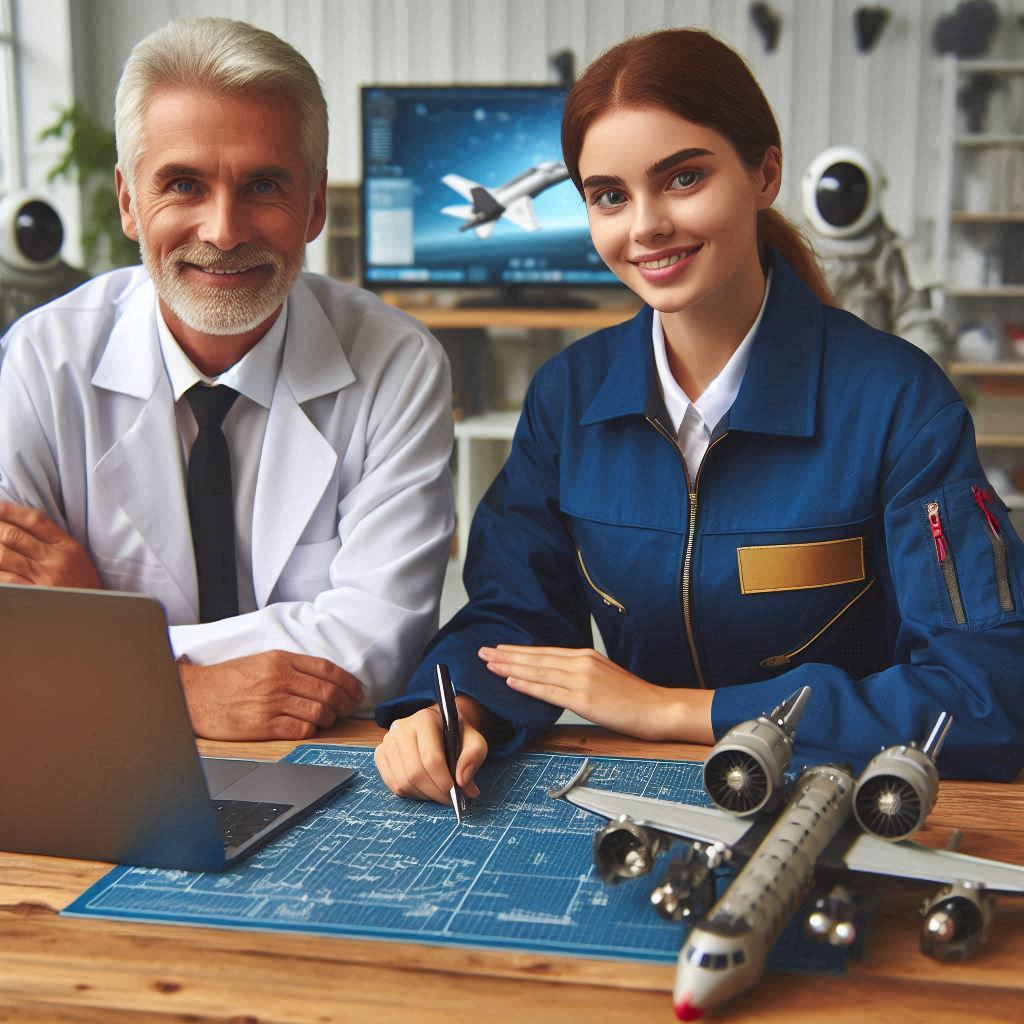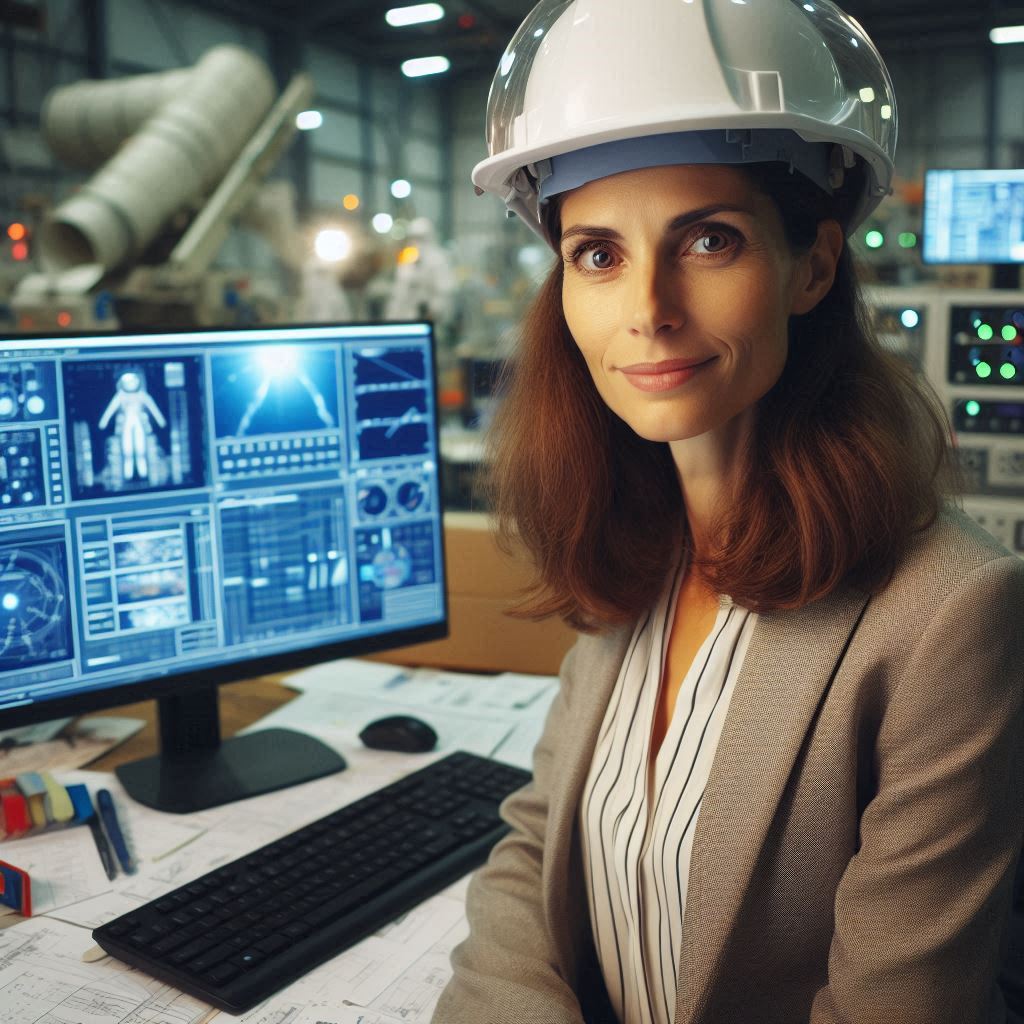Introduction
Aerospace engineering is the discipline that involves the design, development, and testing of aircraft and spacecraft.
It encompasses both aeronautical engineering, which deals with aircraft operating within Earth’s atmosphere, and astronautical engineering, which focuses on spacecraft operating outside Earth’s atmosphere.
This field integrates multiple scientific and engineering principles to create and improve the vehicles and systems that enable air and space travel.
Aerospace engineering is critical to the aviation and space industries.
Engineers in this field work on cutting-edge technologies that enhance the performance, safety, and efficiency of aircraft and spacecraft.
Their work ensures that these vehicles can withstand the rigorous conditions of flight and space travel.
This includes developing advanced materials, propulsion systems, and aerodynamic designs that improve fuel efficiency and reduce environmental impact.
In the aviation industry, aerospace engineers contribute to the design and production of commercial airliners, military jets, helicopters, and unmanned aerial vehicles (UAVs).
Their innovations lead to safer, faster, and more economical air travel.
For instance, the development of more efficient jet engines and lighter composite materials has significantly reduced fuel consumption and emissions in modern aircraft.
Additionally, aerospace engineers play a crucial role in the development of advanced navigation and control systems, which enhance the safety and reliability of air travel.
Aerospace Engineering in Airplane Design
Role of Aerospace Engineers in Designing Airplanes
Aerospace engineers play a pivotal role in designing airplanes.
They are responsible for creating aircraft that are safe, efficient, and capable of performing specific tasks.
Their work involves a thorough understanding of aerodynamics, materials science, propulsion, and avionics.
They collaborate with various specialists to ensure that all components of an airplane work seamlessly together.
From conceptual design to final testing, aerospace engineers oversee the entire development process.
They use advanced simulation tools and wind tunnel testing to refine their designs and predict how the aircraft will perform under different conditions.
Importance of Aerodynamics in Creating Efficient Aircraft
Aerodynamics is crucial in creating efficient aircraft.
It involves the study of how air flows around the airplane, which affects lift, drag, and stability.
Aerospace engineers focus on optimizing the aerodynamic properties of aircraft to enhance performance and fuel efficiency.
Reducing drag is particularly important because it directly impacts the amount of fuel an aircraft consumes.
Engineers achieve this by designing sleek, streamlined shapes that minimize air resistance.
They also use advanced materials and surface treatments to further reduce drag and improve efficiency.
The wings are a critical component in aerodynamic design.
Engineers carefully shape and size the wings to generate the necessary lift while minimizing drag.
Innovations such as winglets, which are small vertical fins at the tips of the wings, have significantly reduced drag and improved fuel efficiency.
Additionally, the integration of laminar flow technologies helps maintain smoother airflow over the wings, further reducing drag.
Examples of Innovative Airplane Designs
Advancements in aerospace engineering have led to several innovative airplane designs.
One notable example is the Boeing 787 Dreamliner.
This aircraft features a composite fuselage, which is lighter and stronger than traditional aluminum.
The use of composites reduces the overall weight of the aircraft, leading to better fuel efficiency and lower operating costs.
The Dreamliner also incorporates advanced aerodynamic features, such as raked wingtips, which enhance performance and reduce fuel consumption.
Another example is the Airbus A350 XWB, designed with an emphasis on aerodynamics and fuel efficiency.
The A350 XWB uses a high percentage of advanced composite materials, which contribute to its lightweight structure.
Its aerodynamic design includes features like sharklet wingtips and optimized wing shapes, resulting in reduced drag and improved fuel economy.
In the realm of supersonic travel, aerospace engineers are working on next-generation designs to reduce sonic booms.
For instance, NASA’s X-59 Quiet Supersonic Technology (QueSST) aims to create a supersonic aircraft that produces a quieter sonic boom, making supersonic travel over land feasible.
This project involves cutting-edge aerodynamic design and advanced materials to achieve its goals.
Satellite Technology and Aerospace Engineering
Aerospace engineers play a crucial role in developing satellite technology, which has profound real-world applications.
Satellites are integral to modern life, enabling a range of services from communication to navigation.
The advancement of satellite technology owes much to the expertise and innovations of aerospace engineers.
Development of Satellite Technology
Aerospace engineers are responsible for designing and building satellites that orbit Earth and beyond.
They work on every aspect of satellite development, from conceptual design to construction and launch.
This includes creating robust structures capable of withstanding the harsh environment of space.
Engineers also focus on the satellite’s propulsion systems, ensuring they can reach and maintain the correct orbit.
The development of miniaturized components allows for smaller, more cost-effective satellites with enhanced capabilities.
How Satellites Are Used
Satellites in Communication
Satellites are pivotal in global communication, enabling voice, video, and data transmission across vast distances.
Aerospace engineers develop communication satellites that facilitate television broadcasts, internet connectivity, and mobile phone networks.
These satellites orbit in geostationary orbits, allowing continuous coverage of specific regions on Earth.
Satellites provide crucial infrastructure for emergency communications and remote areas without access to terrestrial networks.
The reliability and reach of communication satellites have revolutionized global connectivity, making it possible to stay connected anywhere on the planet.
Satellites for Weather Forecasting
Weather forecasting relies heavily on satellite technology.
Aerospace engineers design and deploy weather satellites that monitor atmospheric conditions, track storms, and predict weather patterns.
These satellites provide real-time data crucial for accurate forecasting and early warnings.
Weather satellites use advanced sensors and imaging technologies to capture images of cloud cover, sea surface temperatures, and other meteorological variables.
This information is vital for preparing for natural disasters and understanding climate changes.
Satellites for Navigation
Navigation systems depend on satellite technology for accurate location data.
Aerospace engineers develop navigation satellites, such as those used in GPS systems, that provide precise positioning information.
These satellites help with everything from driving directions to tracking cargo shipments.
The Global Positioning System (GPS) relies on a constellation of satellites working together to provide accurate location and timing information.
This technology supports various applications, including navigation for vehicles, aircraft, and maritime operations.
Advancements in Satellite Technology
Recent advancements in satellite technology are pushing the boundaries of what is possible.
Aerospace engineers are developing smaller, more powerful satellites, known as CubeSats, that offer cost-effective solutions for space missions.
These small satellites can be launched in groups, providing extensive coverage and capabilities.
The integration of advanced materials and manufacturing techniques has led to more durable and efficient satellites.
Innovations such as high-throughput satellites (HTS) and satellite constellations are increasing bandwidth and coverage, enhancing global communication capabilities.
Aerospace engineers significantly impact satellite technology, driving advancements that enhance communication, weather forecasting, and navigation.
Their expertise ensures the development of reliable and innovative satellites that improve our daily lives and contribute to scientific progress.
As technology continues to evolve, aerospace engineers will remain at the forefront of these crucial developments.
Read: Iconic US Buildings and the Architects Behind Them.
Transform Your Career Today
Unlock a personalized career strategy that drives real results. Get tailored advice and a roadmap designed just for you.
Start NowAerospace Engineering in the Space Industry
Aerospace engineers play a critical role in the space industry, contributing to the design, development, and operation of spacecraft for various missions.
Their expertise is crucial in pushing the boundaries of space exploration and advancing our understanding of the cosmos.
Involvement of Aerospace Engineers in Space Exploration
Aerospace engineers are involved in all stages of space exploration, from conceptualization and design to launch and mission control.
They utilize their knowledge of aerodynamics, propulsion, materials science, and other disciplines to ensure the success of space missions.
Conceptualization
Aerospace engineers work closely with scientists and technicians to develop mission concepts that address specific scientific objectives, technological challenges, and budget constraints.
They use computer-aided design (CAD) software to create detailed models of spacecraft and analyze their performance under various conditions.
Design and Development
Aerospace engineers are responsible for designing the structural components, propulsion systems, guidance systems, and other key systems of spacecraft.
They conduct simulations, tests, and prototypes to validate the performance and safety of the spacecraft before it is launched into space.
Launch and Mission Control
Aerospace engineers monitor the launch process, trajectory, and performance of spacecraft throughout the mission.
They make real-time decisions to ensure the safety and success of the mission, troubleshooting any technical issues that may arise during the flight.
Design and Construction of Spacecraft for Missions
Aerospace engineers design and construct spacecraft for a wide range of missions, including missions to the moon, Mars, and beyond.
These missions require spacecraft that can withstand the harsh conditions of space, travel long distances, and perform complex scientific experiments.
Missions to the Moon
Aerospace engineers design lunar landers, rovers, and orbiters to explore the surface of the moon, collect samples, and conduct scientific research.
These spacecraft must be able to navigate the lunar terrain, withstand extreme temperatures, and communicate with Earth-based mission control.
Missions to Mars
Aerospace engineers design Mars rovers, landers, orbiters, and drones to study the Martian surface, atmosphere, and geology.
These spacecraft must be equipped with advanced instruments, cameras, and sensors to collect data and images for scientific analysis.
Significance of Aerospace Engineering in Space Exploration
Aerospace engineering is essential for advancing space exploration, enabling humanity to reach new frontiers, discover new worlds, and answer fundamental questions about the universe.
By designing and building spacecraft, aerospace engineers pave the way for future missions to explore the cosmos and search for signs of life beyond Earth.
Significance of Aerospace Engineering in Pushing the Boundaries of Space Exploration
Aerospace engineering plays a crucial role in pushing the boundaries of space exploration, enabling missions to reach farther into the solar system and beyond.
The expertise of aerospace engineers is essential for overcoming the challenges of space travel, such as propulsion, navigation, communication, and life support.
Advancements in Propulsion Systems
Aerospace engineers develop advanced propulsion systems, such as ion thrusters, nuclear engines, and solar sails, to enable faster and more efficient space travel.
These propulsion systems allow spacecraft to reach distant planets, asteroids, and other celestial bodies within reasonable timeframes.
Exploration of Asteroids and Outer Planets
Aerospace engineers design spacecraft for missions to asteroids, comets, and outer planets, such as Jupiter, Saturn, Neptune, and beyond.
These missions require spacecraft that can withstand high radiation levels, extreme temperatures, and strong gravitational forces.
Search for Extraterrestrial Life
Aerospace engineers contribute to missions that search for signs of extraterrestrial life on other planets, moons, and celestial bodies.
By designing spacecraft with the necessary instruments and sensors, aerospace engineers enable scientists to explore the potential habitats and environments where life may exist beyond Earth.
Ultimately, aerospace engineering plays a crucial role in the space industry, driving innovation, exploration, and discovery.
Aerospace engineers are at the forefront of designing and building spacecraft for missions to the moon, Mars, and beyond, expanding our knowledge of the cosmos and inspiring future generations to reach for the stars.
Read: Diversity in the US Architectural Scene: A Deep Dive

Military Applications of Aerospace Engineering
One crucial area where aerospace engineering plays a vital role is in military applications.
Aerospace engineers contribute to the design, development, and maintenance of military aircraft and defense systems.
Aerospace Engineering in Military Aircraft
Advancements in aerospace engineering have significantly impacted the capabilities of military aircraft.
One key area is stealth technology, which allows aircraft to operate undetected by radar systems.
- Stealth technology involves designing aircraft with features that reduce radar cross-section, making them harder to detect.
- Aerospace engineers work on developing materials and shapes that minimize radar reflection and absorb radar waves.
- Stealth aircraft like the F-22 Raptor and B-2 Spirit are examples of cutting-edge aerospace engineering in military aircraft.
Enhanced Aerial Combat Capabilities
Another significant contribution of aerospace engineering to military applications is the enhancement of aerial combat capabilities.
Aerospace engineers develop systems and technologies that improve aircraft performance in combat situations.
- Advancements in propulsion systems, aerodynamics, and avionics have led to faster, more maneuverable, and more capable military aircraft.
- Aerospace engineers design weapons systems and onboard electronics that give pilots an edge in aerial engagements.
- Unmanned aerial vehicles (UAVs) or drones are another example of aerospace engineering innovation in military applications. These aerial vehicles can perform reconnaissance, surveillance, and combat missions without risking pilot lives.
Contributions to National Security
Aerospace engineers play a crucial role in ensuring national security by developing and maintaining advanced military aircraft and defense systems.
Their contributions directly impact a country’s ability to defend itself and its interests.
Showcase Your Business Today
Reach thousands of readers actively exploring professional services. Publish your business profile and grow your audience now.
Publish Now- By designing aircraft with superior performance and capabilities, aerospace engineers help maintain air superiority in conflicts.
- They work on improving missile defense systems, radar systems, and communication networks to enhance national defense capabilities.
- Aerospace engineers collaborate with military personnel to develop and implement strategies for utilizing aircraft and defense systems effectively in combat situations.
In review, military applications of aerospace engineering are essential for national security and defense.
Aerospace engineers continuously innovate and push the boundaries of technology to ensure that military aircraft and defense systems remain at the forefront of capabilities.
Their contributions play a crucial role in maintaining peace and security in an ever-evolving global landscape.
Read: How to Become a Civil Rights Advocate
Learn More: Nuclear Engineering: Internship and Job Opportunities
Career Opportunities in Aerospace Engineering
Diverse Career Paths in Aerospace Engineering
Aerospace engineering offers a wide range of career paths, each with unique opportunities and challenges.
Engineers in this field can work in aviation, space exploration, defense, and more.
Each sector requires specialized skills and qualifications, reflecting the diverse applications of aerospace technology.
In aviation, aerospace engineers design and improve aircraft, including commercial airliners and private jets.
They work on enhancing performance, fuel efficiency, and safety.
Engineers in this sector might focus on aerodynamic design, propulsion systems, or avionics.
Space exploration presents another exciting career path.
Engineers in this field work on spacecraft, satellites, and space probes.
They tackle challenges such as space travel, satellite deployment, and planetary exploration.
This career path involves designing systems that can withstand harsh space environments and operate reliably.
The defense industry also offers numerous opportunities for aerospace engineers.
Engineers in defense work on military aircraft, missiles, and surveillance systems.
They focus on developing advanced technologies for national security and defense applications.
This sector often involves working on classified projects and requires a high level of security clearance.
Additionally, aerospace engineers find opportunities in emerging fields such as commercial spaceflight and unmanned aerial vehicles (UAVs).
The rise of private space companies and drone technology has expanded career options and introduced new areas of specialization.
Skills and Qualifications Needed
To pursue a career in aerospace engineering, candidates need a strong educational background and specific skills.
A bachelor‘s degree in aerospace engineering or a related field is essential.
Advanced positions may require a master‘s degree or Ph.D. in aerospace engineering or a related discipline.
Key skills for aerospace engineers include proficiency in mathematics and physics.
Engineers must be adept at problem-solving and analytical thinking to tackle complex design and operational challenges.
Technical skills, such as proficiency in computer-aided design (CAD) software and simulation tools, are also crucial.
Strong communication skills are important for working on interdisciplinary teams and presenting technical information clearly.
Additionally, attention to detail and the ability to work under pressure are valuable traits for meeting project deadlines and ensuring high-quality outcomes.
Potential Job Opportunities
Aerospace engineering offers diverse job opportunities across various sectors. In aviation, engineers may work with airlines, aircraft manufacturers, or maintenance organizations.
They might be involved in designing new aircraft, improving existing models, or overseeing maintenance procedures.
In space exploration, opportunities exist with space agencies like NASA or private space companies such as SpaceX and Blue Origin.
Engineers in this sector work on spacecraft design, mission planning, and space technology development.
The defense sector provides roles with military organizations, defense contractors, and research institutions.
Engineers might work on developing advanced weaponry, military aircraft, or defense systems.
Emerging fields such as commercial spaceflight and UAVs offer new career prospects.
Engineers in these areas work on designing commercial space vehicles, developing autonomous drones, and exploring innovative aerospace technologies.
Essentially, aerospace engineering offers diverse career paths in aviation, space exploration, defense, and emerging technologies.
Pursuing a career in this field requires a strong educational background, specific technical skills, and the ability to work on complex challenges.
With opportunities across various sectors, aerospace engineering provides a dynamic and rewarding career for those interested in shaping the future of aerospace technology.
Read: The Intersection: Architecture & Tech in Modern USA.
Future Trends in Aerospace Engineering
Current Trends and Developments in Aerospace Engineering
Aerospace engineering is rapidly evolving with several exciting trends and developments shaping the industry.
One prominent trend is the advancement of unmanned aerial systems, commonly known as drones.
These technologies are revolutionizing industries by enabling new applications in areas such as agriculture, logistics, and surveillance.
Drones provide efficient solutions for tasks like crop monitoring, delivery services, and environmental assessments.
Another significant trend is the push towards supersonic and hypersonic travel.
Companies are developing aircraft capable of traveling faster than the speed of sound, reducing travel times drastically.
Innovations in supersonic travel aim to make long-haul flights quicker and more accessible.
These developments promise to transform global transportation and reduce the time it takes to cross continents.
Emerging Technologies Shaping the Industry
Emerging technologies are dramatically shaping the aerospace industry.
Drones, for instance, are not only expanding their applications but also becoming more sophisticated.
Advances in autonomous flight, improved battery life, and enhanced sensors are making drones more versatile and reliable.
These technologies enable drones to perform complex tasks with greater precision and efficiency.
Supersonic travel is another area of significant innovation.
Companies like Boom Supersonic are working on aircraft that can travel at speeds exceeding Mach 2.
These advancements aim to reduce flight times between major cities, making global travel more convenient.
Supersonic travel also includes a focus on reducing noise pollution and improving fuel efficiency.
The development of electric and hybrid-electric propulsion systems is another exciting trend.
These systems aim to reduce the environmental impact of aviation by lowering emissions and improving fuel efficiency.
Electric propulsion technologies are particularly promising for short-haul flights and urban air mobility solutions.
Hybrid-electric systems are expected to play a crucial role in making aviation more sustainable in the future.
Predictions for the Future and Its Impact on Society
Looking ahead, aerospace engineering will continue to drive significant changes in society.
The widespread adoption of drones is expected to revolutionize industries such as delivery services and emergency response.
Drones could streamline logistics, improve disaster management, and enhance public safety.
Supersonic and hypersonic travel will likely transform global transportation by making long-distance travel faster and more efficient.
This could lead to a more interconnected world, with people able to travel across the globe in a fraction of the time it takes today.
The impact on business, tourism, and international relations could be profound.
Electric and hybrid-electric aircraft will contribute to a more sustainable future for aviation.
By reducing reliance on fossil fuels, these technologies can help lower greenhouse gas emissions and combat climate change.
The aerospace industry‘s shift towards cleaner energy sources will have positive effects on the environment and public health.
Overall, the future of aerospace engineering promises exciting advancements that will shape how we travel, communicate, and interact with our world.
As technology continues to evolve, the industry‘s innovations will have far-reaching impacts on society, enhancing our quality of life and driving progress in numerous sectors.
Conclusion
Aerospace engineering plays a crucial role in shaping various industries, from aviation and space exploration to defense and telecommunications.
Aerospace engineers are at the forefront of innovation, developing advanced technologies that enhance our understanding of the universe and improve the quality of everyday life.
The significance of aerospace engineering extends beyond designing and building aircraft.
Aerospace engineers contribute to the development of efficient aircraft, spacecraft, and satellite systems, pushing the boundaries of science and technology.
These advancements solve critical problems in transportation, communication, and national security.
In aviation, aerospace engineers design and improve aircraft that are faster, safer, and more fuel-efficient.
Their work ensures that passengers can travel around the globe swiftly and securely.
The innovations in aircraft design also play a vital role in reducing environmental impact through improved fuel efficiency and reduced emissions.
In space exploration, aerospace engineers develop spacecraft that explore distant planets and gather valuable scientific data.
These missions expand our knowledge of the universe and contribute to scientific breakthroughs.
The engineering behind satellites enables global communication, weather forecasting, and navigation systems that we rely on daily.
[E-Books for Sale]
The Big Book of 500 High-Paying Jobs in America: Unlock Your Earning Potential
$19.99 • 500 High-Paying Jobs • 330 pages
Explore 500 high-paying jobs in America and learn how to boost your career, earn more, and achieve success!
See All 500 High-Paying Jobs of this E-Book
1001 Professions Without a Degree: High-Paying American Jobs You Can Start Now
$19.99 • 1001 Professions Without a Degree • 174 pages
Discover 1001 high-paying jobs without a degree! Unlock career tips, skills, and success strategies for just $19.99!




